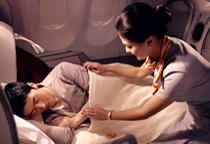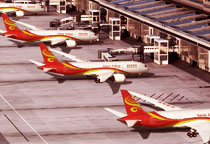Baggage Restrictions

Limits on baggage transportation
A.Prohibited items
Passengers are not allowed to place the following items in their checked baggage or carry them into the passenger cabin; otherwise Hainan Airlines and Grand China Air will refuse to provide transportation services.
I. Firearms and other weapons (including major components), devices capable of firing ammunition (including projectiles and other items) and causing serious personal injury or items that could be mistaken for such devices, mainly including: military guns, official guns, civilian guns, prop guns, firing guns, ball guns, guns outside the country, all kinds of illegally manufactured firearms and simulations of the above items, etc.
II. Dangerous goods, capable of causing serious personal injury or endangering the safety of aircraft and posing a greater danger to the order of transportation, including explosives, gases, flammable liquids, flammable solids, spontaneous combustion substances, substances that release flammable gases in contact with water, oxidizers, organic peroxides, toxic substances, infectious substances, radioactive substances, corrosives and substances and articles not belonging to any of the above categories but dangerous in air transportation. Mainly includes:
- Explosive or incendiary substances and devices or items that could be mistaken for such devices (substances), including ammunition, blasting equipment, pyrotechnic products and simulations of the above items.
- Compressed and liquefied gases, such as hydrogen, methane, ethane, butane, natural gas, ethylene, propylene, acetylene (dissolved in medium), carbon monoxide, liquefied petroleum gas, freon, oxygen (including liquid oxygen devices), carbon dioxide, water gas, lighter fuel and liquefied gas for lighters.
- Spontaneous combustion items, such as yellow phosphorus, white phosphorus, nitrocellulose (including film), oil paper and its products.
- Flammable items in contact with moisture, such as metal potassium, sodium, lithium, calcium carbide (calcium carbide), magnesium and aluminum powder.
- Flammable liquids, such as gasoline, kerosene, diesel, benzene, ethanol (alcohol), acetone, ether, paints, thinners, rosin oil and products containing flammable solvents.
- Flammable solids, such as red phosphorus, flash powder, solid alcohol, celluloid, blowing agent.
- Oxidizing agents and organic peroxides such as potassium permanganate, potassium chlorate, sodium peroxide, potassium peroxide, lead peroxide, peracetic acid, hydrogen peroxide.
- Toxic products, such as cyanide, arsenic, highly toxic pesticides and other highly toxic chemicals.
- Corrosive substances, such as sulfuric acid, hydrochloric acid, nitric acid, sodium hydroxide, potassium hydroxide, mercury (mercury).
- Radioactive materials, such as radioactive isotopes.
- Other items that implicitly contain one or more hazardous materials.
III. Control instruments that have the potential to cause personal injury or pose a significant risk to aviation safety and transport order, mainly including control knives, military and police instruments, and other control instruments as stipulated by the state.
IV. Other articles that have the potential to cause personal injury or pose a significant risk to aviation safety and transport order, mainly including
- Infectious disease pathogens, such as hepatitis B virus, anthrax bacillus, tuberculosis bacillus, and AIDS virus.
- Tinder (including various ignition devices), such as lighters, matches, cigarette lighters, and magnesium rods (flints).
- Power banks and lithium batteries with a lithium content of more than 8 grams or a rated energy of more than 160WH (watt-hours) (lithium batteries used in electric wheelchairs are otherwise regulated).
- Alcoholic beverages with an alcohol volume percentage exceeding 70%.
- Strong magnets, items with a strong, pungent smell or likely to cause panic among passengers, and items of an indeterminate nature with potential danger.
V. Security briefcases, cash boxes, cash bags, and other confidential equipment containing dangerous goods, such as lithium batteries and pyrotechnic devices, are strictly prohibited from being carried on board (except for the confidential equipment that meets the requirements of Article 2.3.2.6 of IATA's Dangerous Goods Regulations).
VI. Irritating or incapacitating devices, such as Mace, pepper spray, etc.
VII. Small gaseous oxygen cylinders (or air cylinders) and liquid oxygen devices for medical use.
VIII. Gun-type electronic dry powder fire extinguisher.
IX. Electroshock weapons (such as Tasers) that contain dangerous goods, such as explosives, compressed gases, and lithium batteries.
X. Matches of any kind (including friction matches and safety matches), lighters (including lighter fuel), and lighters driven by lithium batteries.
XI. Small scooters driven by lithium batteries, such as self-balancing scooters, unicycles, scooters, bicycles, etc., and related accessories.
XII. Self-heating ready-to-eat foods, such as self-heating rice (including instant rice and food heating packs).
XIII. Lithium batteries that may have safety defects, such as discarded lithium batteries, lithium batteries recalled by manufacturers, damaged or swollen lithium batteries, etc. Devices, such as the Samsung Galaxy Note7, are strictly prohibited in carry-on, checked, or hand baggage.
XIV. Avalanche rescue backpacks.
XV. Wild animals and animals with strange characteristics that may pose a risk, such as snakes, wolfdogs, Tibetan mastiffs, etc., do not fall into the scope of small animals and cannot be transported as baggage, except for those handled in compliance with the pet transportation regulations of Hainan Airlines and Grand China Air.
XVI. Articles that Hainan Airlines and Grand China Air consider unsuitable for transportation for the following reasons: dangerousness, lack of safety, packaging, weight, volume, size, shape, and nature of articles, as well as fragile or perishable articles taking into account the aircraft type, etc.
XVII. Other articles prohibited from transportation as stipulated by national laws, administrative regulations, and rules.
XVIII. Articles that are prohibited from exiting, entering, or transiting the People's Republic of China or the countries they pass through according to the laws of these countries.
B. Common special items:
- Items that require personal care should not be checked in or placed in checked baggage. Instead, they should be brought into the cabin as hand baggage. Examples of such items include important documents (contracts and agreements), medications, securities, currency, bills of exchange, jewellery, precious metals and their products, silver products, valuables, antiques, paintings, fragile and perishable items, samples, electronic and digital products, travel documents, medical certificates, X-rays, prescription medications that need to be taken at regular intervals, as well as any other items that require personal attention.
- Regarding liquid items, pleaseclick here to view details.
- Regarding lithium and rechargeable batteries, please refer to the "Lithium Battery Transportation Service" and "Rechargeable Battery Transportation Service" for detailed information.
- Spare batteries (including lithium batteries, nickel-metal hydride batteries and various types of dry batteries) for portable electronic devices, power banks and portable power stations are only permitted in the cabin and are prohibited in checked baggage.
- Precision instruments and electrical appliances, such as DVD players, video recorders, televisions, audio equipment, and other similar items, should be transported as cargo. If they are transported as checked baggage, they must be appropriately packaged.
- The carriage of sports equipment (including starting pistols and their ammunition) as checked baggage requires the prior consent of Hainan Airlines and Grand China Air.
- Certain small animals may be transported as checked baggage,Please click hereto view the specific requirements.
- Diplomatic bags and confidential documents must be carried by the correspondent or diplomatic courier and handled with care. On request, they can be treated as checked baggage.
- Please click here to view the special requirements for folding and electric wheelchairs used by passengers during the flight.
- Sharp or blunt objects other than controlled knives such as kitchen knives, dinner knives, fruit knives, craft knives, scalpels and scissors as well as steel files, iron cones, axes, short rods and hammers must be transported in checked baggage.
- Certain items that are prohibited but pose little risk to flight safety and are urgently needed for normal use may be accepted as carry-on baggage, provided that an appropriate certificate is issued and the items cannot easily be used to hijack an aircraft. For example, if a limited amount of medical supplies or instruments such as alcohol swabs are required to care for a seriously ill passenger seeking medical treatment at their destination, these can be taken into the cabin with the authorisation of the airport, Hainan Airlines or Grand China Air.
- Fruits that emit an unpleasant odour or may disturb other passengers, such as durian and jackfruit, are prohibited from being brought into the cabin. However, they can be placed in checked baggage and securely sealed in cardboard or plastic containers to prevent any odours from escaping.
- Carriage of securely packaged UN 0012 1.4S ammunition (intended solely for use in group sports competitions), camping stoves and fuel containers containing flammable liquid fuel, approved security equipment, non-infectious samples packed with minimal flammable liquids, combustion and fuel cell engines, and osmosis devices is strictly prohibited in the cabin. Check-in procedures can only proceed with our approval.
- Carriage of securely packaged UN 0012 1.4S ammunition (intended solely for use in group sports competitions) and osmosis devices: Please make necessary preparations beforehand and present the certification/MSDS sheets to the airport personnel as evidence of compliance with our regulations.
- Eligible security equipment, chemicals, monitoring devices: Please make necessary preparations beforehand and present the certification/MSDS sheets to the airport personnel as evidence of compliance with our regulations.
- Non-infectious samples packed with minimal flammable liquids: Please make necessary preparations beforehand and present to the airport personnel an appraisal report issued by the Health Commission or a medical unit within China at the county or municipal level or at the same level (e.g., national grade 2A) or above, with official seal (including the date of issuance).
- Regarding dry ice (solid carbon dioxide) for the preservation of fresh and perishable items, passengers are permitted to carry a maximum of 2.5kg with our approval. The package must have vent poles to release the gas. Meanwhile, dry ice (solid carbon dioxide) cannot be transported alone as carry-on or checked baggage. It must be transported alongside the perishable items.
If you have any questions or feedback, kindly contact the 24-hour booking service hotline of Hainan Airlines and Grand China Air at 95339.
C.Checked Baggage Weight and Size Limitations
Checked in baggage shall be packed, locked or tied securely, be able to bear certain pressure, can be safely loaded or unloaded under normal operations, and must be subject to the following rules:
- Travelling cases, bags and handbags shall be locked.
- Two or more bags cannot be tied together as one.
- No other items can be attached to the baggage.
- Bamboo basket, string bag, straw ropes, straw bags and other similar articles cannot be used as a package of baggage.
- Baggage with dangerous markings or tags cannot be used. The dangerous markings or tags shall be removed or covered before the baggage can be used.
- Sawdust, rice husk or grass items cannot be used as padding in the baggage.
- The edges and corners of the hard material outer packaging and the irregular, uneven or sharp protrusions of the packaging surface must be softened, and the soft packing lining materials (such as: foam, sponge, linen, cardboard, bubble film, etc.) must play a protective role in principle to avoid rubbing.
Transporting Lithium Batteries
Pursuant to the current valid ICAO Technical Instructions for the Safe Transport of Dangerous Goods by Air (applicable to both international and domestic flights), the following serves as a reminder of the regulations for the transportation of lithium batteries in passengers' baggage:
- Electronic devices (watches, calculators, cameras, cell phones, laptops, portable video cameras, etc.) intended for passengers' personal use with batteries containing ≤2 grams of lithium (lithium metal batteries) and rated energy ≤100Wh (watt-hour, lithium-ion batteries) may be transported as checked baggage or hand baggage. If the rated energy of the battery in the device exceeds 100Wh but does not exceed 160Wh, the device may still be transported as checked baggage or hand baggage, subject to approval from Hainan Airlines and Grand China Air. When transporting these electronic devices as checked baggage, please make sure to pack them properly in advance to prevent accidental damage. At the same time, these electronic devices must be powered off, and appropriate measures should be taken to prevent them from being accidentally powered on during transportation.
- Spare lithium batteries are strictly prohibited as checked baggage and can only be carried on board. Spare lithium batteries carried on board should be individually protected against short circuit, and the recommended way is to place each battery into a small box or a lithium battery transport bag. Please note that rechargeable batteries are also regarded as lithium batteries, and therefore, the standards for transporting lithium batteries apply to rechargeable batteries carried by passengers as well. Moreover, it is strictly forbidden to use rechargeable batteries to charge cell phones or any other electronic devices on board.
- Spare lithium batteries of electronic devices for passengers' personal use with lithium content ≤2 grams or rated energy ≤100Wh shall be carried on board as hand baggage. Spare lithium batteries with rated energy >100Wh and ≤160Wh shall be carried on board as hand baggage, subject to approval from Hainan Airlines and Grand China Air, and limited to a maximum of 2 pieces.
- Lithium-ion battery-powered wheelchairs or similar mobility devices carried by passengers and portable medical electronic devices containing lithium metal or lithium-ion battery cells or batteries carried by passengers for medical purposes and their spare batteries must be carried in accordance with the latest version of the Technical Instructions for the Safe Transport of Dangerous Goods by Air and approved by Hainan Airlines and Grand China Air. Spare batteries of ≤160Wh or ≤8g for portable electronic medical devices must be carried on board as hand baggage after obtaining approval from Hainan Airlines and Grand China Air and are limited to a maximum of 2 pieces per passenger.
- Lithium batteries for electric wheelchairs or other mobility devices must be carried on board as hand baggage, subject to approval from Hainan Airlines and Grand China Air, and are limited to a maximum of 2 pieces per passenger, provided that the rated energy of the batteries is ≤160Wh, and 1 piece per passenger provided that the rated energy of the batteries is >160Wh and ≤300Wh.
- The transportation of Samsung Galaxy Note7s, small self-balancing scooters with lithium batteries (and their equivalents: unicycles, mobility devices, hoverboards, etc.), and relevant parts is strictly prohibited as both hand baggage and checked baggage.
- Safe briefcases, cash boxes, cash bags, and other confidential equipment that contain dangerous items such as lithium batteries and pyrotechnic devices are prohibited from transport.
Regulations for brining portable phone chargers
According to China Civil Aviation Administration requirements, the following provisions apply to passengers bringing portable phone chargers:
Portable phone chargers refer to mobile power sources for lithium batteries whose main function to provide an external power supply to mobile phones and other electronic devices. Under the currently valid ICAO Air Transport of Dangerous Goods Safety Technical Instructions and China Civil Aviation Transportation of Dangerous Goods Regulations, passengers bringing
portable phone chargers shall comply with the following provisions:
1. Passengers can only bring portable phone charges for personal use.
2. Portable phone chargers can only be transported as hand luggage. It is prohibited to transport them in checked baggage.
3. Portable phone chargers with rated energy not exceeding 100 Wh do not require the airline's approval; those with rated energy exceeding 100 Wh but not exceeding 160 Wh must have airline approval before they can be transported; each passenger may not bring more than two portable phone chargers.
4. Portable phone chargers with a rated energy exceeding 160 Wh are not allowed to be transported; portable phone chargers whose rated energy value is not marked and whose rated energy cannot be calculated through other marked parameters are not allowed to be transported.
5. Portable phone chargers cannot be used during the flight to charge electronic devices. Portable phone chargers that have an on-off switch should be switched off from the beginning of the flight to its end.
Methods for determining the rated energy of portable phone chargers:
f the rated energy value of the portable phone charger is not directly marked in Wh (watt-hours), the portable phone charger’s rated energy can be calculated in the following manner:
1. If the nominal voltage(V) and the nominal capacity(Ah) of the portable phone charger are known, the rated energy value can be calculated:
Wh= V x Ah
The nominal voltage and nominal capacity are usually marked on the portable phone charger.
2. If the portable phone charger is only marked with mAh, this value can be divided by 1,000 to get the ampere hours (Ah) value.<
Examples: If a portable phone charger has a nominal voltage of 3.7 V, and a nominal capacity of 760 mAh, its rated energy will be:
760 mAh ÷ 1,000 = 0.76 Ah
3.7 V × 0.76 Ah = 2.9 Wh
Transportation Services for Powder Articles
I. Tips for Inspection of Powder Articles for Passengers travelling to the United States
Starting from June 30, 2018, the United States has implemented focused inspections on powder articles carried by passengers travelling to the United States. Powder articles with a container volume (single) exceeding 350ml (including) and articles presented in a solid state by compressing powdery materials (such as flour, sugar, coffee, spices, and pastries) cannot be brought into the cabin. If you need to carry such articles, please arrange your trip in advance and check them in at the airport.
The following two types of special powder articles must meet the following requirements if they are to be brought into the cabin.
(1)For powder articles such as medical drugs, infant formula, and cremated remains
Ensure that the packaging is intact and without any signs of damage (including cracks, punctures, etc.). If the packaging is not sealed or displays any signs of damage, ensure that the articles inside the packaging match the description on the packaging.
(2) For powder articles purchased by you at the airport duty-free shops
Ensure that they are sealed in a container or a sealed bag and undergo inspection by airport security personnel.
II. Tips for Inspection of Powder Articles for Outbound Passengers from Australia and New Zealand
Starting from June 30, 2018, Australia and New Zealand have implemented focused inspections on powder articles carried by passengers departing on international flights. Inorganic powder articles with a container volume (single) exceeding 350ml (including) cannot be brought into the cabin. If you need to carry such articles, please arrange your trip in advance and check them in at the airport.
The following two types of special powder articles are exempt from the above regulations. If you need to bring them into the cabin, they must meet the following requirements.
(1) For organic powdery materials, such as medical drugs, infant formula, coffee, protein powder, laxatives (magnesium sulfate), and cremated remains
Ensure that the packaging is intact and without any signs of damage (including cracks, punctures, etc.). If the packaging is not sealed or displays any signs of damage, ensure that the articles inside the packaging match the description on the packaging.
(2) For powder articles purchased by you at the airport duty-free shops
Ensure that they are sealed in a container or a sealed bag and undergo inspection by airport security personnel.





